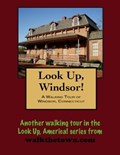There is no better way to see America than on foot. And there is no better way to appreciate what you are looking at than with a walking tour. This walking tour of Windsor, Connecticut is ready to explore when you are. Each walking tour describes historical, architectural landmarks, cultural sites and ecclesiastic touchstones and provides step-by-step directions.
Every tour also includes a quick primer on identifying architectural styles seen on American streets.
In 1635, Reverend John Warham brought 60 of his congregation overland from Dorchester, Massachusetts and stopped here where the Farmington River flows into the Connecticut River. They had arrived in America five years earlier on the ship Mary and John from Plymouth, England. Reverend Warham promptly renamed the settlement Dorchester. During the next few years, more settlers arrived from Dorchester, outnumbering and soon displacing the original Plymouth contingent, who mostly returned to Plymouth. In 1637, the colony's General Court changed the names of Connecticut's three original river towns - Dorchester to Windsor, Watertown to Wethersfield and Newtown to Hartford.
It did not take long for the settlers to find a way to make a living. In 1640 the first tobacco was planted in Connecticut in Windsor and the first curing shed brought from Virginia. By 1700, tobacco was being exported via the Connecticut River to European ports and the use of Connecticut tobacco as a cigar wrapper leaf began was widespread by the early 1800s. Eventually there would be over 15,000 Connecticut River Valley in cultivation to grow tobacco. More than 2,000 acres remain so today. Before the 18th century arrived the brick-making trade was also flourishing in Windsor; there was time when the town boasted more than 40 brickyards.
The original town of Windsor comprised what is now the towns of Windsor, Windsor Locks, East Windsor, South Windsor, Granby, East Granby, Simsbury, Ellington, and parts of several other Connecticut towns. Even so, today's Windsor is spread out geographically, covering some 30 square miles. And our walking tour will be spread out as well, connecting the Broad Street Green with the Palisado Green on either side of the Farmington River, a distance of about a quarter-mile...

